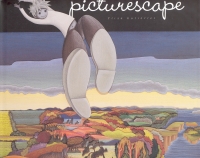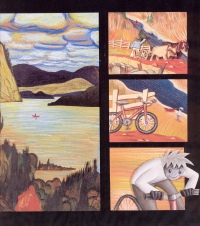| ________________
CM . . .
. Volume XII Number 7 . . . .November 25, 2005
Picturescape is a wordless picture book which will be enjoyed by children of all ages on their own and by children with their parents and teachers. It was created by Elisa Gutiérrez, a graphic designer from Mexico City who now lives with her husband in Vancouver. This is her first book. The title, Picturescape—a synthesis, perhaps, of "picture," "landscape" and "escape"—gives us a preview of what is to come. Turning the pages of the book, we follow the adventures of a young boy as he leaves his rather bland home behind and explores the landscapes, mostly exuberantly-coloured paintings, in his local art gallery while on a tour with his classmates. Gutiérrez, in fact, worked as a volunteer with school tours at the Vancouver Art Gallery when she first arrived in Canada, and her experiences with that program inspired this book. All together, there are 12 well-known Canadian artists featured in the book, and the young protagonist imagines himself flying—or sailing, cycling, canoeing, swimming —into and out of a selection of their artworks, one by one. He explores both the details of the paintings and the different regions of Canada, from the West Coast to the Maritimes. One regret: there are no aboriginal or northern artists represented. However, the works selected for the book do exhibit a range of styles and approaches to landscape.
It is clear that the visit to the art gallery is a life-altering experience for the young boy. At the beginning of the book, his lack of visual awareness is signaled by both a grey collage on the front endpapers and a grey bedroom on the first page of the story. At the end of the book, the boy's bedroom is lit with sparks of colour, and the closing endpapers are alive with coloured collage. Art clearly has the power to make him—and us—see the visual excitement in our everyday surroundings. Picturescape is a wonderful book for a number of reasons. It is a perfect introduction to art appreciation in general and an art gallery excursion in particular. It encourages young people—and older ones, too—to use their imaginations and invent stories starting with the images they encounter in art galleries, books and elsewhere. It could also lead to the production of personal artworks by young viewers who are inspired by other paintings which they imagine they have walked into or flown through. A surprise feature of Picturescape is that it has its own website (www.picturescape.ca). Designed for older readers, parents and teachers, it contains valuable written material to complement the picture book. There are sections with information about the artist and her collage techniques, brief biographies of each of the Canadian artists highlighted in the book (with website links), a list of children's programs at art galleries across Canada (with more links) and a charming, 30-second animation, based on the book's story, with original piano-cello music. Finally, the website offers a place for teachers and parents to submit ideas for ways of using the book, an interactive feature which is sure to be popular. Highly Recommended. Ann Stinner is a former art education instructor in the Faculty of Education at the University of Manitoba in Winnipeg, MB.
To comment
on this title or this review, send mail to cm@umanitoba.ca.
Copyright © the Manitoba Library Association. Reproduction for personal
use is permitted only if this copyright notice is maintained. Any
other reproduction is prohibited without permission.
NEXT REVIEW |
TABLE OF CONTENTS FOR THIS ISSUE
- November 25, 2005.
AUTHORS |
TITLES |
MEDIA REVIEWS |
PROFILES |
BACK ISSUES |
SEARCH |
CMARCHIVE |
HOME |

 The illustrations are a delight. Gutiérrez has used her own special collage technique for all the images in the book, including her representations of the specific works of Emily Carr, William Kurelek, Lawren Harris, and the other artists. She cuts coloured paper, some of it highly textured, into the needed shapes and then hand-colours each of these with pencil crayon before combining all the pieces into the final composition. Visually, the layout of the pages is exciting and varied, with a mixture of panoramic aerial views, close-ups, small sequenced frames, and large double-page spreads. Exaggerated perspective creates extra drama in selected spots and, drawing our eye to the right-hand edge, images and details push us to keep turning the pages.
The illustrations are a delight. Gutiérrez has used her own special collage technique for all the images in the book, including her representations of the specific works of Emily Carr, William Kurelek, Lawren Harris, and the other artists. She cuts coloured paper, some of it highly textured, into the needed shapes and then hand-colours each of these with pencil crayon before combining all the pieces into the final composition. Visually, the layout of the pages is exciting and varied, with a mixture of panoramic aerial views, close-ups, small sequenced frames, and large double-page spreads. Exaggerated perspective creates extra drama in selected spots and, drawing our eye to the right-hand edge, images and details push us to keep turning the pages.